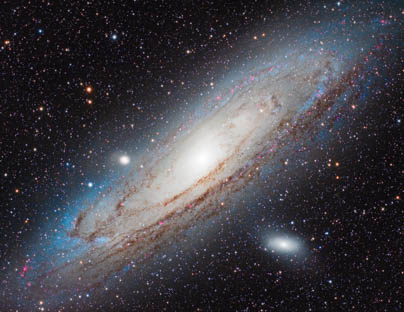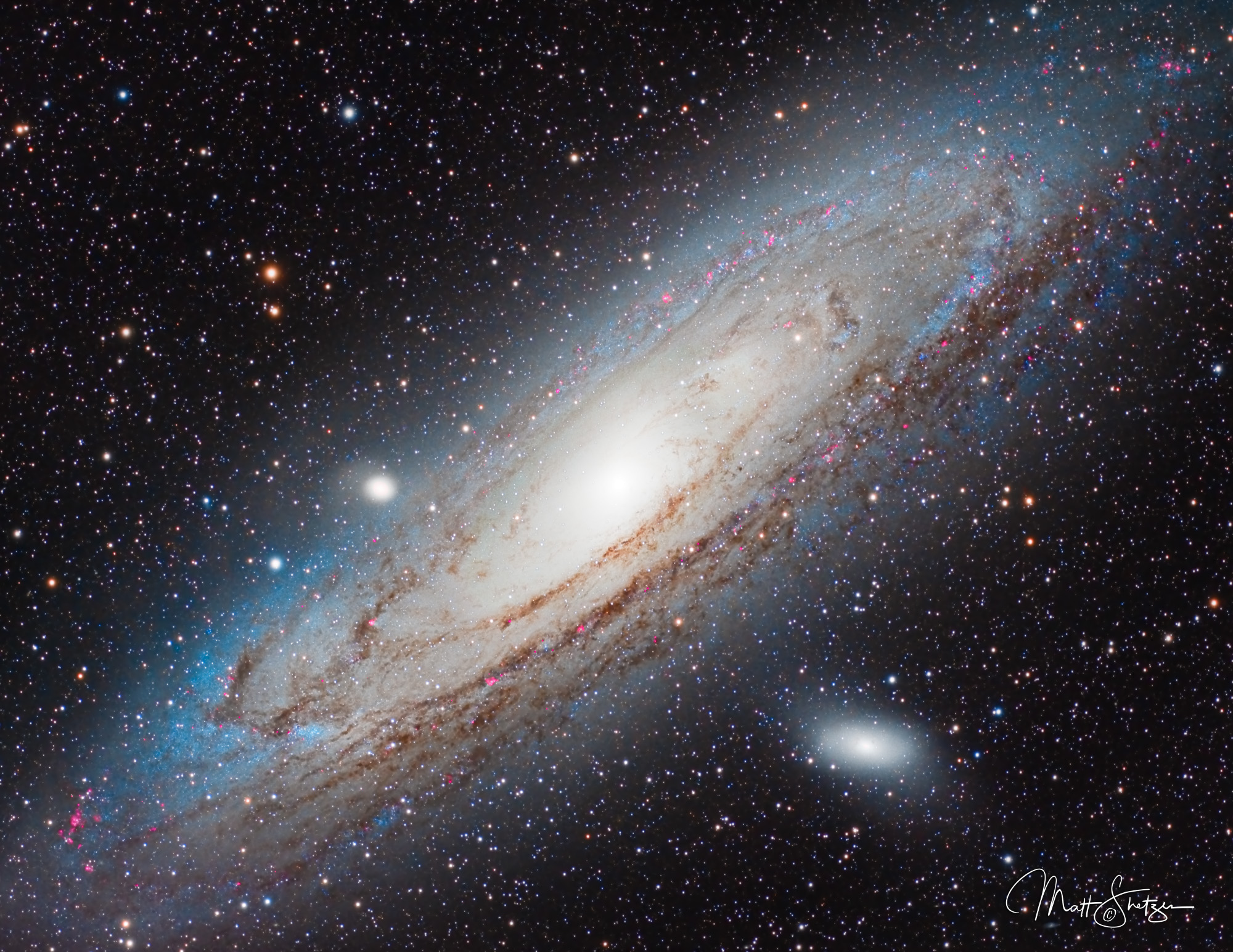The Andromeda Galaxy, or M31, is a large barred spiral galaxy located about 2.5 million light-years away from Earth. and the nearest large galaxy to the Milky Way. Andromeda contains over 1 trillion stars and has a radius as wide as 11,000 light years. The Andromeda Galaxy is six times larger than the moon.
Cataloged as Messier 31 or NGC 224, this deep sky object is observable for much of the year in the northern hemisphere, lying in the constellation Andromeda, next to Cassiopeia.
The Andromeda Galaxy is the brightest galaxy you can see with your naked eye appearing as a smudge of light in the Andromeda constellation. What you are seeing visually is its extremely bright core. With a telescope, you will see the detail and the dust lanes between the spiral arms of the galaxy.
In 4-5 Billion years, The Milky Way and Andromeda galaxies are expected to collide merging to form a massive elliptical or lenticular galaxy.
Messier 31, also shows its satellite galaxies, Messier 110 and Messier 32.
| Object | Andromeda Galaxy |
| Link | https://www.shetzers.com/andromeda-galaxy-m31/ |
| Wiki Link | https://en.wikipedia.org/wiki/Andromeda_Galaxy |
| Hemisphere | Northern |
| Constellation | Andromeda |
| Other Names contained in image | Messier 31, M31, NGC 224,Andromeda Galaxy |
| Imaging telescopes or lenses | Takahashi FSQ -106ED4 |
| Imaging cameras | QHY268M |
| Mounts | Software Bisque Paramount MYT |
| Focal reducers | None |
| Software | Software Bisque The Sky X, PHD Lab PHD2, Voyager, Viking, PixInsight, Photoshop, Lightroom |
| Filters | Astrodon LRGB Gen2 E-Series Tru-Balance 36mm unmounted. Chroma Technology Narrowband 3nm Ha, SII, OIII – 36mm Unmounted |
| Accessories | Moonlite NightCrawler 35 focuser, Maxdome II, Digital Loggers Pro Switch, Sky Alert Weather Station, Pegagsus Ultimate Powerbox v2, Starlight Xpress filter wheel. |
| Guiding Telescope or Lenses | Orion 60mm Guide Scope |
| Guiding Camera | ZWO ASI224MC Guide Camera |
| Imaging Dates | 12/18/21, 12/19/21, 1/22/22, 1/23/22, 1/30/22 |
| Frames | Luminance: 36×300″ (3h) Gain 25, Photographic Mode, Temp -25C, Bin 1×1 Red: 20×300″ (1.6h) Gain 25, Photographic Mode, Temp -25C, Bin 1×1 Green: 20×300″ (1.6h) Gain 25, Photographic Mode, Temp -25C, Bin 1×1 Blue: 20×300″ (1.6h) Gain 25, Photographic Mode, Temp -25C, Bin 1×1 Ha: 10×1200″ (3.3h) Gain 60, High Gain Mode, Temp -25C, Bin 1×1 |
| Integration | 11.5 hours |
| Darks | 50 |
| Flats | 19 per Filter |
| Flat Darks | 40 |
| Bortle Dark-Sky Scale: | 2 |
| RA center | 00 42 41.722 |
| DEC center | 41 16 55.69 |
| Pixel scale | 3.76 |
| Resolution | 6280 x 4210 |
| Locations | Sirus 3.5m Observatory, Carbondale Colorado |
| Data source | Backyard |
| Seeing | Average |
| Bortles | 2 |
| Post Processing Techniques | PixInsight to Photoshop to Lightroom |
| Median FWHM Pixels | L 2.598, R 2.517, G 2.45, B 2.748, Ha 2.613 |


